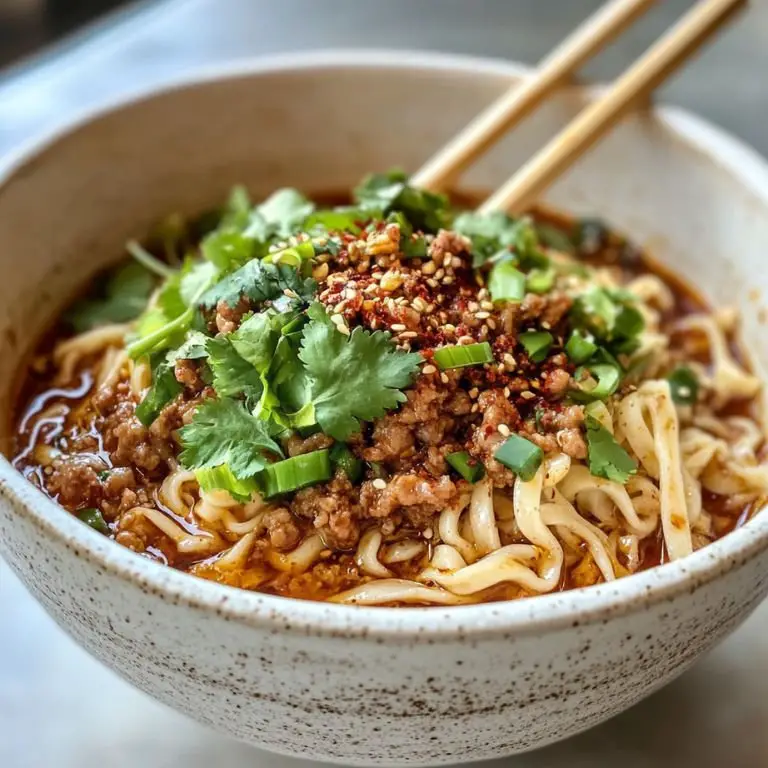Dan Dan Noodles is a beloved street food from Sichuan, China, known for its bold, spicy chili oil, nutty sesame flavor, and savory meat topping. This version of Dan Dan Noodles is a faithful take on the traditional recipe, blending homemade chili oil sauce with ground pork and aromatic aromatics. This article dives deeper than just the recipe—exploring ingredients, helpful equipment swaps, cooking tips, pairings, and FAQs—so you can master this iconic Rice Noodle Dishes staple at home.
Chinese Dan Dan Noodles with Chili Oil Sauce
Prep Time 25 minutes mins
Cook Time 20 minutes mins
Total Time 45 minutes mins
Course Main Course
Cuisine Chinese
Servings 4 generous bowls
Large pot for boiling noodles
Small saucepan to warm broth
Frying pan or wok for browning meat
Heatproof bowl for preparing chili oil sauce
Fine sieve or mesh strainer (for peppercorns or sesame)
Grater for ginger
Garlic press or knife
Wooden Spoon or Spatula
Noodle & Broth
- 350 g 12 oz wheat noodles (recommend alkaline-style, but Chinese egg noodles work fine)
- 4 cups chicken stock homemade preferred
- 2 tbsp light soy sauce
Meat Topping
- 250 g 9 oz ground pork (or ground chicken or turkey)
- 2 tbsp vegetable oil
- 1 tbsp Shaoxing wine
- 1 tsp dark soy sauce
Chili Oil Sauce
- 3 tbsp Sichuan chili flakes adjust spice
- 8 cloves garlic minced
- 1½ tbsp ginger finely grated
- 3 tbsp sesame paste tahini or smooth peanut butter as substitutes
- 2 tbsp Chinkiang vinegar black vinegar
- 2 tsp sugar
- 2 tbsp soy sauce
- ½ cup neutral oil peanut or canola
Aromatics & Garnish
- 4 scallions finely sliced
- 1 cup cilantro roughly chopped
- 3 tbsp toasted Sichuan peppercorns ground
- 2 tbsp toasted sesame seeds
Optional: blanched hakurei turnips or napa cabbage ribbons
Prepare the Chili Oil Sauce
In a heatproof bowl, combine garlic, ginger, chili flakes, sesame paste, vinegar, sugar, and soy sauce.
Warm neutral oil to just below smoking. Carefully pour oil over the mixture; it will sizzle and bloom. Stir gently until smooth and creamy.
This sauce is the hallmark of Dandan Noodles—no shortcuts, please. Use quality soy sauce, and don’t substitute the sesame paste with peanut butter, which alters the nutty profile.
Cook the Meat Topping
Heat vegetable oil in a pan or wok on medium-high.
Add ground pork and break it apart with a spatula. Cook until browned and crisp, ~6–8 minutes.
Stir in Shaoxing wine and dark soy sauce, cook 1–2 minutes more until caramelized.
Set aside the meat in a bowl and retain any flavorful drippings in the pan.
Warm the Broth
Warm chicken stock in a saucepan. Mix in light soy sauce and adjust seasoning to taste.
Keep broth warm on low until serving.
Cook the Noodles
Bring a large pot of water to a rapid boil.
Add noodles and cook per package instructions until al dente.
Drain, rinse under cold water to prevent sticking, then portion into bowls.
Toss noodles with a drizzle of chili oil sauce and a splash of broth to prevent clumping.
Assemble the Bowls
Spoon 2 Tbsp of chili oil sauce into each bowl over noodles.
Add warm broth to fill bowls ¾ full.
Top with a generous portion of the browned pork.
Garnish with scallions, cilantro, ground Sichuan peppercorns, and sesame seeds.
Pairings
Beverages
- Chilled jasmine tea or Chinese Pu-erh—cleanses the palate and balances spice
- Light lager or crisp pilsner—complements without overpowering
- Sparkling water with lime—refreshing counterpoint to fiery broth
Side Dishes
- Cucumber salad with garlic and vinegar—cool crunch
- Steamed bok choy with garlic sauce—vegetable balance
- Potstickers (guotie)—meaty or vegetable dumplings with soy-dipping sauce
FAQs
1. What type of noodles are best?
Choose alkaline wheat noodles—their springy texture holds up in hot broth. You’ll find them in Chinese grocery stores labeled “Dan Dan Noodles.” Thick ramen-style noodles also work.
2. Can I use chicken or turkey instead of pork?
Yes! Ground chicken or turkey are excellent alternatives. The technique stays the same, though you may need slightly less cooking time due to lower fat content.
3. What cut of pork is ideal?
Lean ground pork with some fat helps crisp up in the pan. If using your own grind, choose pork shoulder or a lean pork/beef mix. For ultra-lean, add a teaspoon of oil to aid browning.
4. Is tahini OK instead of sesame paste?
Tahini or smooth peanut butter can substitute for the sesame paste element, but you’ll lose some of the natural roastiness. I recommend sticking with Asian sesame paste, which has a rich toasted profile.
5. How to adjust the spice level?
Use less chili oil sauce per bowl, or reduce the chili flake amount. For milder taste, omit Sichuan peppercorns from garnish—these add both heat and numbing sensation (“mala”)
